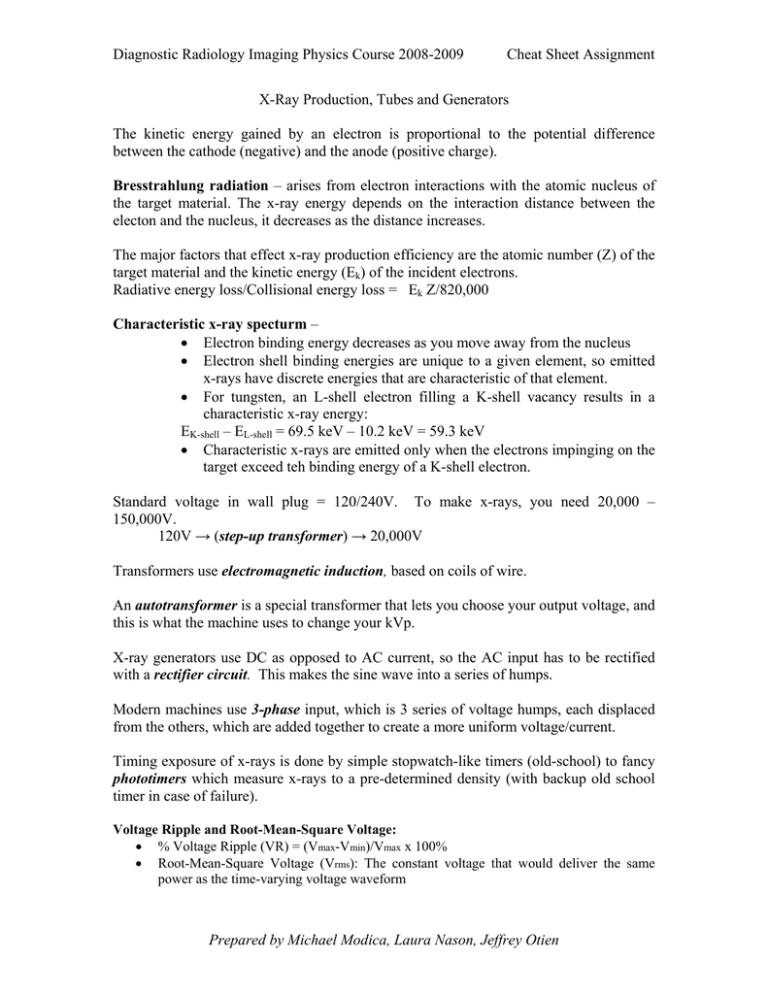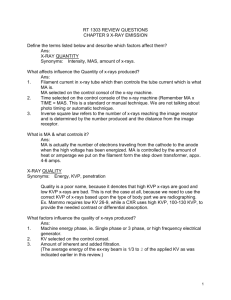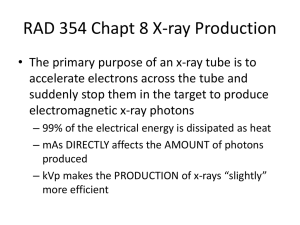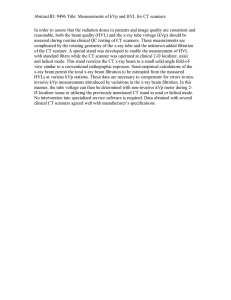The kinetic energy gained by an electron is proportional to the
advertisement

Diagnostic Radiology Imaging Physics Course 2008-2009 Cheat Sheet Assignment X-Ray Production, Tubes and Generators The kinetic energy gained by an electron is proportional to the potential difference between the cathode (negative) and the anode (positive charge). Bresstrahlung radiation – arises from electron interactions with the atomic nucleus of the target material. The x-ray energy depends on the interaction distance between the electon and the nucleus, it decreases as the distance increases. The major factors that effect x-ray production efficiency are the atomic number (Z) of the target material and the kinetic energy (Ek) of the incident electrons. Radiative energy loss/Collisional energy loss = Ek Z/820,000 Characteristic x-ray specturm – • Electron binding energy decreases as you move away from the nucleus • Electron shell binding energies are unique to a given element, so emitted x-rays have discrete energies that are characteristic of that element. • For tungsten, an L-shell electron filling a K-shell vacancy results in a characteristic x-ray energy: EK-shell – EL-shell = 69.5 keV – 10.2 keV = 59.3 keV • Characteristic x-rays are emitted only when the electrons impinging on the target exceed teh binding energy of a K-shell electron. Standard voltage in wall plug = 120/240V. To make x-rays, you need 20,000 – 150,000V. 120V → (step-up transformer) → 20,000V Transformers use electromagnetic induction, based on coils of wire. An autotransformer is a special transformer that lets you choose your output voltage, and this is what the machine uses to change your kVp. X-ray generators use DC as opposed to AC current, so the AC input has to be rectified with a rectifier circuit. This makes the sine wave into a series of humps. Modern machines use 3-phase input, which is 3 series of voltage humps, each displaced from the others, which are added together to create a more uniform voltage/current. Timing exposure of x-rays is done by simple stopwatch-like timers (old-school) to fancy phototimers which measure x-rays to a pre-determined density (with backup old school timer in case of failure). Voltage Ripple and Root-Mean-Square Voltage: • % Voltage Ripple (VR) = (Vmax-Vmin)/Vmax x 100% • Root-Mean-Square Voltage (Vrms): The constant voltage that would deliver the same power as the time-varying voltage waveform Prepared by Michael Modica, Laura Nason, Jeffrey Otien Diagnostic Radiology Imaging Physics Course 2008-2009 • Cheat Sheet Assignment As %VR È, the Vrms Ç Operator Console: • Tech selects peak kilovolts (kVp), current (mA), exposure time (sec) and focal spot size • kVP determines x-ray beam quality (penetrability) which plays role in subject contrast • mA determines x-ray fluence rate (photons/cm²-sec) emitted by x-ray tube at a given kVp (mAs = mA x sec which is proportionate to photons/cm² or fluence) • Low mA selections allow small focal spot while higher mA settings require large focal spot size Phototimers: • Although a tech can manually time the x-ray exposure, phototimers help provide a consistent exposure to the image receptor • Ionization chambers produce a current that induces a voltage difference in an electronic circuit • Tech chooses kVp; the x-ray tube current terminates when induced voltage = reference voltage Factors Affecting X-ray Emission: Quantity = # of x-rays in beam Proportionate to Ztarget x (kVp)² x mAs Quality = penetrability of x-ray beam and depends on: - kVp - Generator waveform (%VR) - Tube filtration (mm AI) Exposure depends on both quantity and quality Changes in kVp can be compensated by changes in mAs to maintain the same exposure Power Ratings and X-ray Tube Focal Spots: • Describes the energy per unit time that the generator can supply • Power (kW) = 100 kVp x Amax (for a 0.1 second exposure) o 100 kW = 100 kVp x 1000 mA @ 100 ms exposure o Amax (tube current) limited by the focal spot: Ç focal spot → Ç power rating • Generally range = 10 kW to 150 kW • Typical focal spots: Prepared by Michael Modica, Laura Nason, Jeffrey Otien Diagnostic Radiology Imaging Physics Course 2008-2009 o o Cheat Sheet Assignment Radiography: 0.6 and 1.2 mm Mammography: 0.1 and 0.1 mm X-ray Tube Heat Loading: • Energy deposition on anode (during x-ray production, 99% heat production) • Heat Unit (HU) = kVp x mAs x factor (factor = 1.0 for 1-phase generator, 1.35 for 3-phase & HF generators, 1.4 for CP generator) • Energy (J) = Vrms x mA x sec (Vrms = 0.71 for 1-phase, 0.95-0.99 for 3-phase & HF and 1.0 for CP) • Heat Input (HU) ~ 1.4 x Heat input (J) Exposure Rating Charts: • Determine operational limits and permissible heat load of anode and tube housing • Charts show the limitation and safe techniques for operation of the system • Parameters affecting rating charts include focal spot size, anode rotation speed, anode angle, anode diameter and generator type (1-phase, 3-phase, HF) Sample Exposure Rating Chart * Sources include lecture slides at http://courses.washington.edu/radxphys/PhysicsCourse.html, Bushberg et al, The Essential Physics of Medical Imaging, http://www.antonine-education.co.uk/Physics_A2/options/Module_9/Topic_3/ripple_10.gif and http://health.siemens.com/med/rv/x_ray_tubes/faqs/default.asp Prepared by Michael Modica, Laura Nason, Jeffrey Otien




